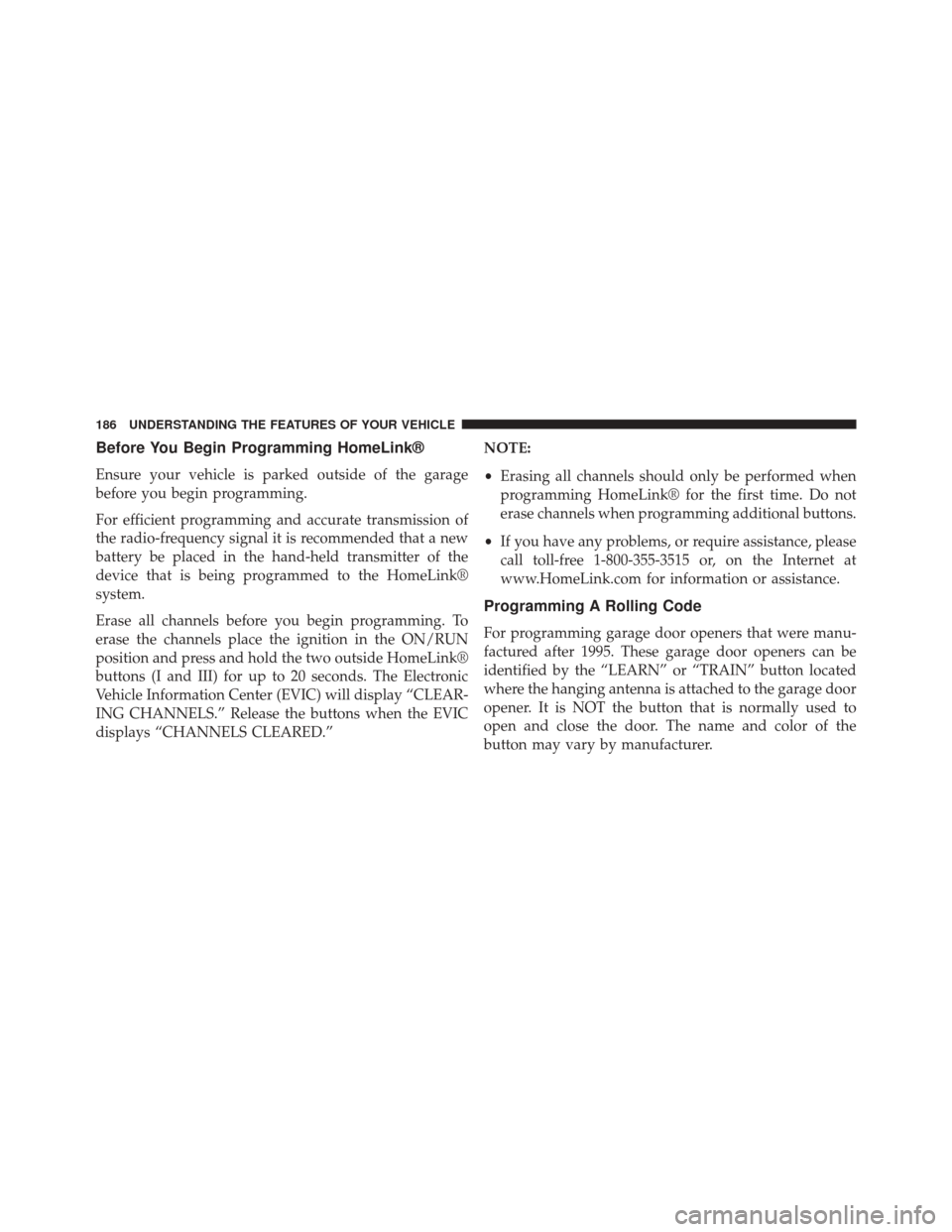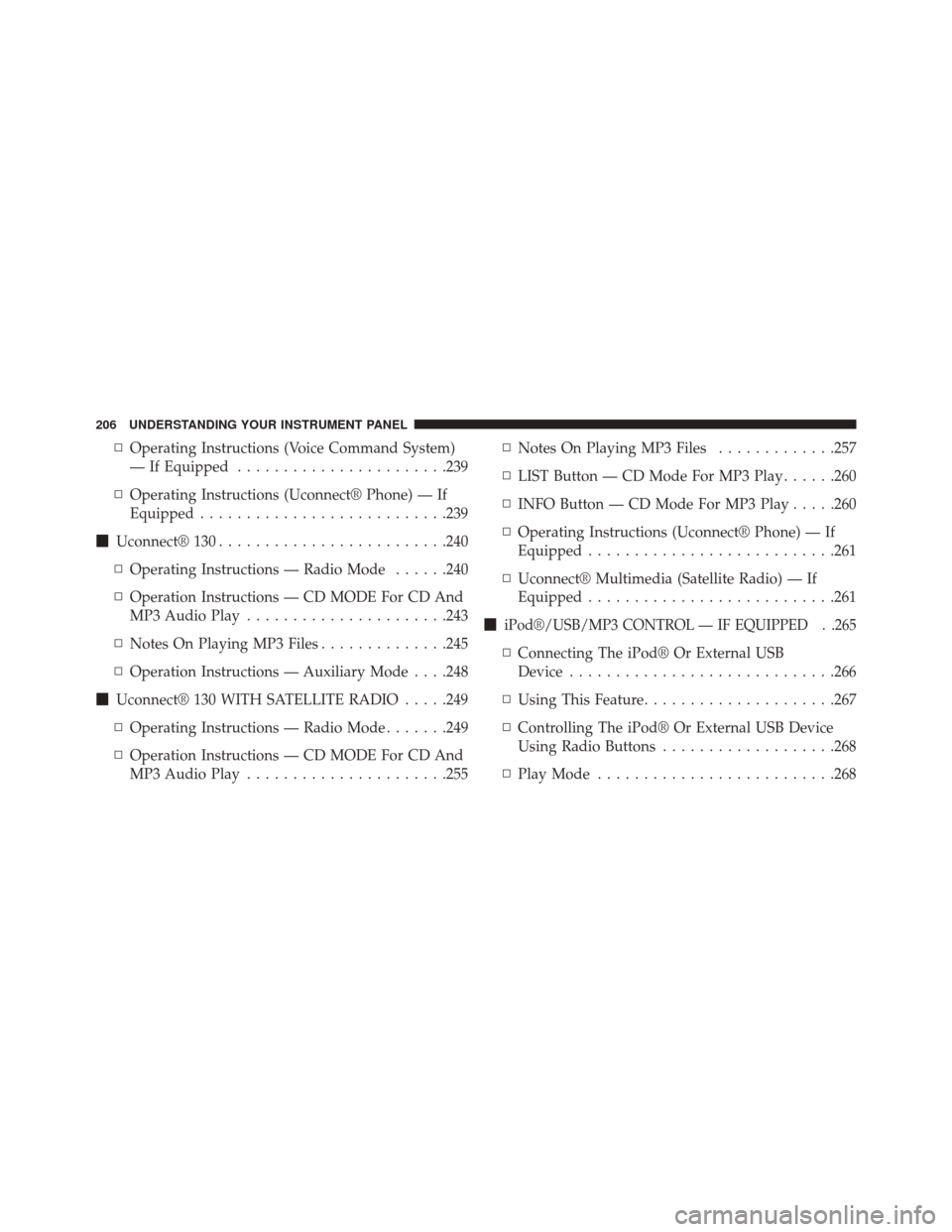Page 182 of 539
The vehicle is close to the obstacle when the EVIC display shows one flashing arc and sounds a continuous tone. The
following chart shows the warning alert operation when the system is detecting an obstacle:
WARNING ALERTS
Rear Distance (in/cm) Greater than
59 in (150 cm) 59-39 in
(150-100 cm) 39-25 in
(100-65 cm) 25-12 in
(65-30 cm) Less than
12 in (30 cm)
Audible Alert Chime None
Single 1/2
Second Tone Slow
FastContinuous
Arcs None3 Solid
(Continuous) 3 Slow
Flashing 2 Slow
Flashing 1 Slow
Flashing
Radio Volume Reduced No
Yes YesYes Yes
NOTE: ParkSense® will reduce the volume of the radio,
if on, when the system is sounding an audio tone.
180 UNDERSTANDING THE FEATURES OF YOUR VEHICLE
Page 184 of 539

or other obstruction and then cycle the ignition. If the
message continues to appear see an authorized dealer.
If�SERVICE PARK ASSIST SYSTEM� appears in the
EVIC, see an authorized dealer.
Cleaning The ParkSense® System
Clean the ParkSense® sensors with water, car wash soap
and a soft cloth. Do not use rough or hard cloths. Do not
scratch or poke the sensors. Otherwise, you could dam-
age the sensors.
ParkSense® System Usage Precautions
NOTE:
• Ensure that the rear bumper is free of snow, ice, mud,
dirt and debris to keep the ParkSense® system oper-
ating properly. •
Jackhammers, large trucks, and other vibrations could
affect the performance of ParkSense®.
• When you turn ParkSense® off in DRIVE, the instru-
ment cluster will display �PARK ASSIST SYSTEM
OFF� for five seconds. Furthermore, once you turn
ParkSense® off, it remains off until you turn it on
again, even if you cycle the ignition key.
• When you move the shift lever to the REVERSE
position and ParkSense® is turned off, the EVIC will
display “PARK ASSIST SYSTEM OFF” message for as
long as the vehicle is in REVERSE.
• ParkSense®, when on, will MUTE the radio when it is
sounding a tone.
182 UNDERSTANDING THE FEATURES OF YOUR VEHICLE
Page 188 of 539

Before You Begin Programming HomeLink®
Ensure your vehicle is parked outside of the garage
before you begin programming.
For efficient programming and accurate transmission of
the radio-frequency signal it is recommended that a new
battery be placed in the hand-held transmitter of the
device that is being programmed to the HomeLink®
system.
Erase all channels before you begin programming. To
erase the channels place the ignition in the ON/RUN
position and press and hold the two outside HomeLink®
buttons (I and III) for up to 20 seconds. The Electronic
Vehicle Information Center (EVIC) will display “CLEAR-
ING CHANNELS.” Release the buttons when the EVIC
displays “CHANNELS CLEARED.”NOTE:
•
Erasing all channels should only be performed when
programming HomeLink® for the first time. Do not
erase channels when programming additional buttons.
• If you have any problems, or require assistance, please
call toll-free 1-800-355-3515 or, on the Internet at
www.HomeLink.com for information or assistance.
Programming A Rolling Code
For programming garage door openers that were manu-
factured after 1995. These garage door openers can be
identified by the “LEARN” or “TRAIN” button located
where the hanging antenna is attached to the garage door
opener. It is NOT the button that is normally used to
open and close the door. The name and color of the
button may vary by manufacturer.
186 UNDERSTANDING THE FEATURES OF YOUR VEHICLE
Page 192 of 539

Canadian/Gate Operator Programming
For programming transmitters in Canada/United States
that require the transmitter signals to “time-out” after
several seconds of transmission.
Canadian radio frequency laws require transmitter sig-
nals to time-out (or quit) after several seconds of trans-
mission – which may not be long enough for HomeLink®
to pick up the signal during programming. Similar to this
Canadian law, some U.S. gate operators are designed to
time-out in the same manner.
It may be helpful to unplug the device during the cycling
process to prevent possible overheating of the garage
door or gate motor.
1. Turn the ignition switch to the ON/RUN position.
2. Place the hand - held transmitter 1 to 3 inches (3 to 8cm) away from the HomeLink® button you wish to
program. 3. Simultaneously press and hold both the Homelink®
button while you press and release (“cycle”), your
hand - held transmitter every two seconds.
4. Continue to hold buttons until the EVIC display changes from “CHANNEL # TRAINING” to “CHAN-
NEL # TRAINED,” then release both buttons.
NOTE: •It may take up to 30 seconds or longer in some cases
for the channel to train.
• If the EVIC displays “DID NOT TRAIN” repeat from
Step 2.
5. Press and hold the programmed HomeLink® button. The EVIC will display “CHANNEL # TRANSMIT.” If
the device is plugged in and activates, programming is
complete.
If you unplugged the garage door opener/device for
programming, plug it back in at this time.
190 UNDERSTANDING THE FEATURES OF YOUR VEHICLE
Page 208 of 539

▫Operating Instructions (Voice Command System)
— If Equipped ...................... .239
▫ Operating Instructions (Uconnect® Phone) — If
Equipped .......................... .239
� Uconnect® 130 ........................ .240
▫ Operating Instructions — Radio Mode ......240
▫ Operation Instructions — CD MODE For CD And
MP3 Audio Play ..................... .243
▫ Notes On Playing MP3 Files ..............245
▫ Operation Instructions — Auxiliary Mode . . . .248
� Uconnect® 130 WITH SATELLITE RADIO .....249
▫ Operating Instructions — Radio Mode .......249
▫ Operation Instructions — CD MODE For CD And
MP3 Audio Play ..................... .255▫
Notes On Playing MP3 Files .............257
▫ LIST Button — CD Mode For MP3 Play ......260
▫ INFO Button — CD Mode For MP3 Play .....260
▫ Operating Instructions (Uconnect® Phone) — If
Equipped .......................... .261
▫ Uconnect® Multimedia (Satellite Radio) — If
Equipped .......................... .261
�
iPod®/USB/MP3 CONTROL — IF EQUIPPED . .265
▫ Connecting The iPod® Or External USB
Device ............................ .266
▫ Using This Feature .....................267
▫ Controlling The iPod® Or External USB Device
Using Radio Buttons ...................268
▫ Play Mode ......................... .268
206 UNDERSTANDING YOUR INSTRUMENT PANEL
Page 209 of 539
▫List Or Browse Mode ...................269
▫ Bluetooth® Streaming Audio (BTSA) .......271
� HARMAN KARDON® Logic7® HIGH
PERFORMANCE MULTICHANNEL SURROUND
SOUND SYSTEM WITH DRIVER-SELECTABLE
SURROUND (DSS) — IF EQUIPPED .........272
� STEERING WHEEL AUDIO CONTROLS — IF
EQUIPPED .......................... .274
▫ Radio Operation ..................... .274
▫ CD Player .......................... .275�
CD/DVD DISC MAINTENANCE ...........275
� RADIO OPERATION AND MOBILE PHONES . .276
� CLIMATE CONTROLS ...................276
▫ Automatic Temperature Control (ATC) ......276
▫ Automatic Operation ...................277
▫ Blower Control ...................... .278
▫ Manual Operation .....................278
▫ Operating Tips ...................... .282
4
UNDERSTANDING YOUR INSTRUMENT PANEL 207
Page 210 of 539
INSTRUMENT PANEL FEATURES
1 — Air Outlets6 — ESC OFF Switch11 — Ignition Switch
2 — Instrument Cluster 7 — Sport Button12 — Trunk Release Button
3 — Glove Compartment 8 — Hazard Warning Switch13 — Headlight Switch
4 — Radio 9 — Heated Steering Wheel Switch
5 — Heated Seat Switch 10 — Climate Control
208 UNDERSTANDING YOUR INSTRUMENT PANEL
Page 212 of 539

INSTRUMENT CLUSTER DESCRIPTIONS
1. Fuel Gauge
The pointer shows the level of fuel in the fuel tank when
the ignition switch is placed in the ON/RUN position.
2. Trip Odometer Button
Press this button to change the display from odometer to
either of two trip odometer settings. The letter “A” or “B”
will appear when in the trip odometer mode. Push in and
hold the button for two seconds to reset the trip odometer
to 0 miles (km). The odometer must be in TRIP mode to
reset it.
3. Speedometer
Indicates vehicle speed.4. Electronic Speed Control Indicator Light
This light will turn on when the electronic
speed control is on.
5. Tachometer
The red segments indicate the maximum permissible
engine revolutions per minute (RPM x 1000) for each gear
range. Ease up on the accelerator before reaching the red
area.
6. Charging System Warning Light This light shows the status of the electrical charg-
ing system. The light should turn on when the
ignition switch is placed in the ON/RUN position and
remain on briefly as a bulb check. If the light stays on or
turns on while driving, turn off some of the vehicle’s
non-essential electrical devices (i.e., radio) or slightly
increase engine speed (if at idle). If the light remains on,
210 UNDERSTANDING YOUR INSTRUMENT PANEL